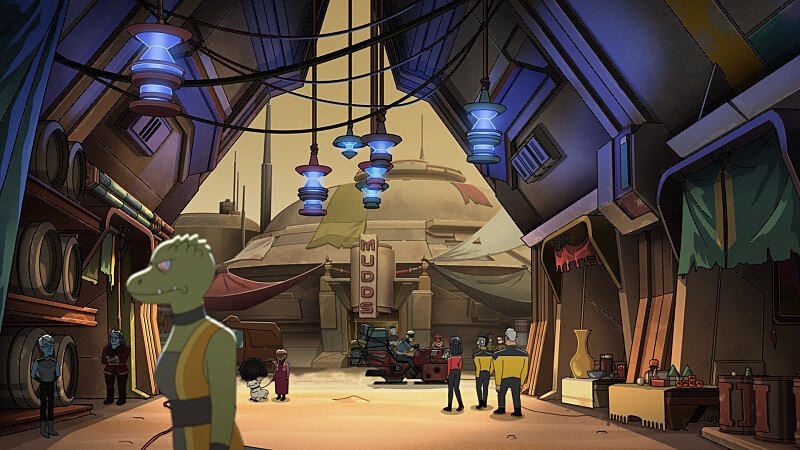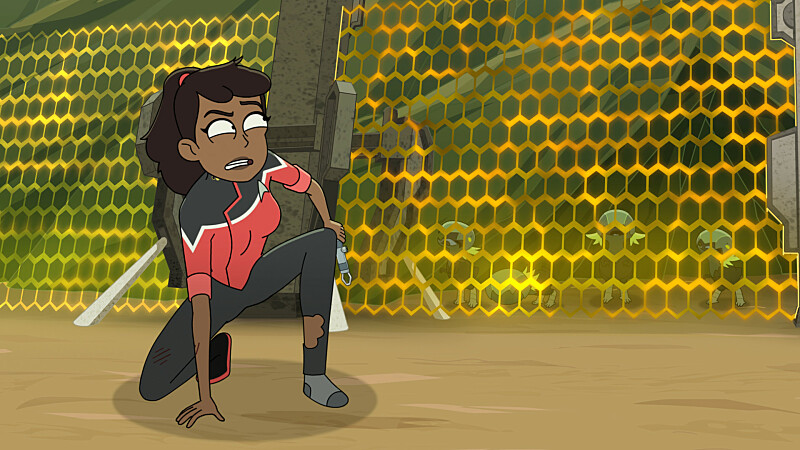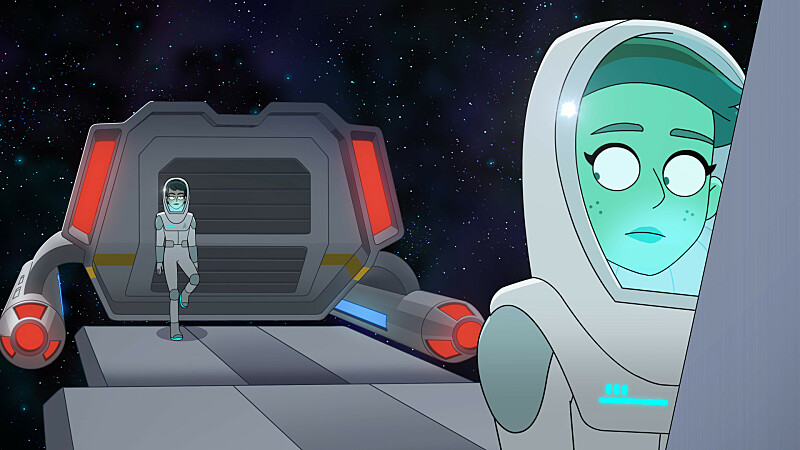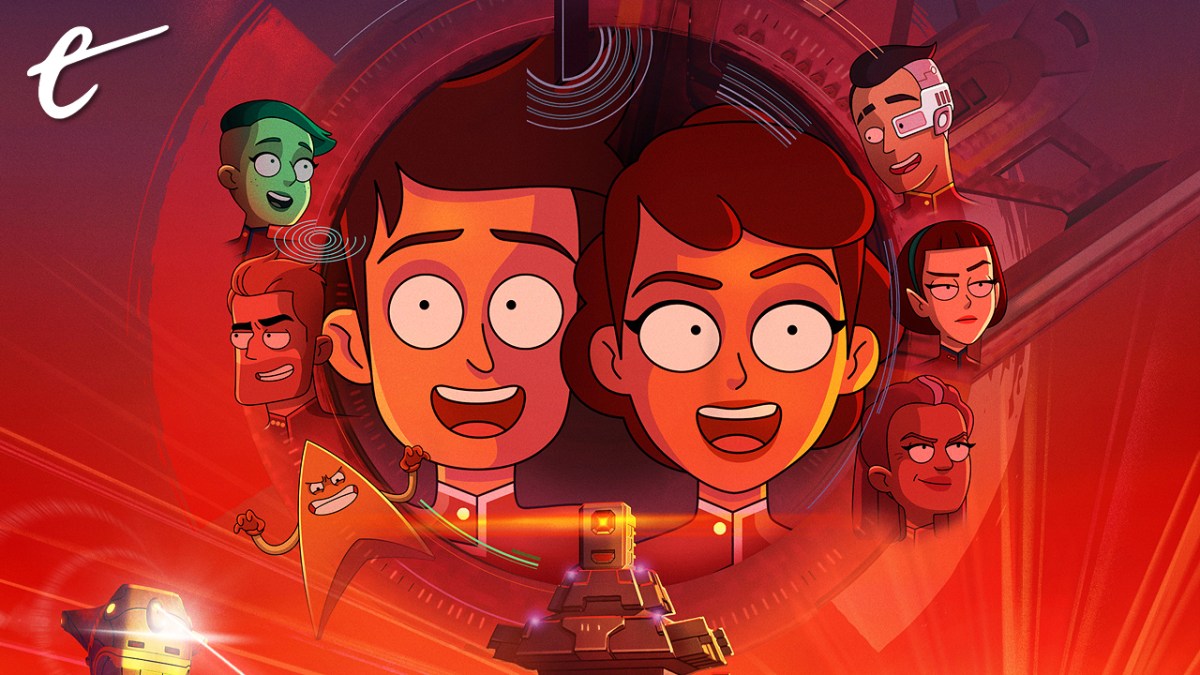Warning: The following review and recap contains spoilers for Star Trek: Lower Decks Season 4, Episode 9, “The Inner Fight.”
“The Inner Fight” is a mess of an episode, one that finds itself doing a lot of heavy lifting to set up a finale that should have been seeded better through the preceding eight episodes.
The fourth season of Star Trek: Lower Decks has been remarkably less focused than the third season. The third season built organically to its finale, properly seeded elements like the introduction of characters such as Admiral Les Buenamigo (Carlos Alazraqui) and Petra Aberdeen (Georgia King) along with plot points like Rutherford’s (Eugene Cordero) lost past and even character arcs like Mariner’s (Tawny Newsome) growing dissatisfaction with Starfleet.
All these elements came together for a satisfying season finale, producing perhaps the best single season of a Star Trek television series in the past half-decade. It was thematically cohesive and narratively efficient, and it made a compelling case for Lower Decks as the most consistently reliable of the ongoing Star Trek shows. In contrast, the fourth season has felt much clumsier and less consistent, drifting particularly aimlessly in its second half.
The penultimate episode of the third season, “Trusted Sources,” was able to tell its own satisfying narrative while also organically setting up the finale, “The Stars at Night.” In contrast, “The Inner Fight” has to spend most of its runtime engaged in setup, covering ground that probably could have been more carefully seeded across the previous eight episodes. The result is an episode that doesn’t really work on its own terms. Instead, it’s half an hour of legwork.
This is evident in both of the episode’s central plot threads, but is most obvious in the storyline focusing on Mariner. The cold open finds Mariner risking her life to save a set of “outpost scientists.” Then, after the opening credits, Boimler (Jack Quaid) and T’Lyn (Gabrielle Ruiz) deliver exposition about how Mariner has become increasingly reckless and self-destructive following her trip to Ferenginar in “Parth Ferengi’s Heart Place.”
“Another violent away mission with Mariner,” Boimler opines. “She’s been off the rails for weeks.” Even Mariner’s mother, Captain Freeman (Dawnn Lewis) has noticed. She summons the show’s core cast to a briefing on the topic. “Why is my daughter trying to get herself killed?” she demands. It’s a decidedly inelegant setup. This sort of blunt exposition might make sense if introducing a new character, like Barclay (Dwight Schultz) in “Hollow Pursuits,” but Mariner is a series regular.

The audience has spent several weeks with Mariner since “Parth Ferengi’s Heart Place,” and there has been no indication of this dangerous behavior. The closest point of comparison might be her decision to accompany Rutherford in his confrontation with Badgey (Jack McBrayer) in “A Few Badgeys More,” but that just seemed like the show’s standard way of divvying up the cast across story threads. Mariner certainly didn’t seem any more reckless than usual in “Caves.”
This is bad storytelling. It harks back to the worst impulses of the 1990s Star Trek shows for which Lower Decks nostalgically yearns. Indeed, Mariner’s character arc in “The Inner Fight” specifically recalls that of B’Elanna Torres (Roxann Dawson) in “Extreme Risk,” in which a generally rebellious member of the main cast engages in increasingly dangerous activities. It’s a character beat that comes out of nowhere. It isn’t seeded in previous episodes, and it is never even acknowledged again.
Of course, both “The Inner Fight” and “Extreme Risk” try to retrofit some clumsy justification for this sudden change in a main cast member’s behavior. In “Extreme Risk,” it is revealed that Torres is simply having a delayed reaction to news of her friends’ deaths, which she had received during the previous season. Similarly, in “The Inner Fight,” Mariner digs deep into her long-standing issues with Starfleet as an institution. In both cases, this is all stuff that could have been properly established and paid off.
There is something deeply frustrating about this. Star Trek: Voyager was episodic because it existed in a very different television landscape, where these shows were designed to be syndicated. Indeed, by the time that Voyager was airing, American television was moving past this model of standalone episodes. Star Trek: Deep Space Nine was embracing long-form serialization, allowing it to tell compelling and complex stories that weren’t confined by the runtime of a single episode.
Lower Decks has always been a nostalgic show, evoking the episodic structure of Voyager. However, Lower Decks elevated itself by balancing this with more ambitious and experimental instincts. “The Inner Fight” is a prime example of the limitations of the rigid episodic form, where these seemingly important character beats both come out of nowhere and disappear into nothing. As Mariner acknowledges in the cold open, this reduces her entire character to a problem of the week.
However, the fourth season of Lower Decks has been much less interested in character development than the third season was, as demonstrated by the troubles that it has been having establishing T’Lyn’s place within the cast. The third season set up its finale by seeding character arcs and motivations, themes, and narrative threads. In contrast, the bulk of work that the fourth season has been doing to set up its season finale has just been hitting repetitive plot beats.
There is a mysterious ship that has been abducting various craft. This seems to be the season’s big threat. So, across the fourth season, there have been a number of cold opens focusing on this strange entity attacking Klingons (“Twovix”), Romulans (“I Have Now Bones Yet I Must Flee”), Orions (“Something Borrowed, Something Green”), Ferengi (“Parth Ferengi’s Heart Place”), and Bynars (“A Few Badgeys More”). This is, to put it mildly, a terrible way to set up a season-long arc.

In practice, this approach just means subjecting the audience to the same scene over and over and over again. A new ship is introduced. New characters are established. Then a mysterious visitor appears and the ship is blasted. Nothing new is learned. Nothing is properly set up. These scenes could easily be trimmed from their respective episodes and nothing would be lost. It’s just really bad long-form storytelling, a massive step down from the previous season.
It doesn’t help that “The Inner Fight” completely changes the logic of this arc to spur the plot to action. “Command has new intel on the attacks from the last couple of months,” explains Ransom (Jerry O’Connell). “They’ve all been non-Federation ships, but now someone is targeting ex-Starfleet officers.” This would have been something nice to set up. Maybe the audience didn’t need to see the Ferengi and the Bynar attacks, but could have seen an attack on an ex-Starfleet officer instead.
It’s a shame, because there is some potentially interesting stuff tucked away within “The Inner Fight,” but most of it gets lost in the rush to cover as much ground as possible and is undermined by a lack of commitment. It’s unfortunate to keep comparing the third and fourth season of Lower Decks, because the comparison rarely flatters this fourth season, but the third season had a much more interesting and compelling view of the larger Star Trek universe. In particular, it saw beyond Starfleet.
“The Inner Fight” teases an ambivalence about Starfleet. It is a recurring joke during Freeman’s attempts to track down outlaw Nick Locarno (Robert Duncan McNeill) on New Axton. New Axton is presented as a stereotypical outlaw world, recalling Nimbus III in Star Trek V: The Final Frontier, Farius Prime in “Honor Among Thieves,” or Freecloud in “Stardust City Rag.” However, much of the humor of “The Inner Fight” derives from the condescension that Freeman has for this criminal world.
For most of the episode, Freeman assumes Starfleet’s inherent superiority to those who live outside the structures of the Federation. It’s a source of frustration to local residents. “You can’t just park that thing in orbit like it doesn’t impact our thermosphere,” protests a ground traffic controller when the Cerritos arrives in orbit. “We got rules.” When Freeman protests New Axton is supposed to be lawless, he replies, “Just because we don’t smooch Federation butt, we’re all trash, huh?”
Later, when Freeman tries to skip the line to get into a local dive bar, the bouncer (Paul Scheer) calls her out, “You can’t just walk in like you’re better than everyone.” When she roughs up the local information broker for tips on Locarno’s location, he protests, “You Starfleet people think you can pick up and shake anyone you want.” It’s a fun parody of the way that Star Trek characters tend to act in these situations, with an air of assumed superiority to the people who live and work in these environments.

It recalls the presentation of Ornara in “Trusted Sources,” a planet so horrifically scarred by Federation intervention in “Symbiosis” that it wanted nothing to do with Starfleet. Unfortunately, “The Inner Fight” lacks the courage of its convictions. Ultimately, it’s revealed that Starfleet is inherently superior to these locals, and these locals were wrong to call out Freeman’s attitude. “I used their bias against them,” Freeman boasts, explaining it was all an elaborate manipulation.
Something similar happens with Mariner’s plot, as she talks about her motivations and her history with Ma’ah (Jon Curry). She reveals that she went to the Academy with Sito Jaxa (Shannon Fill), a minor character who appeared in two episodes of Star Trek: The Next Generation. Sito trained with Locarno in “The First Duty,” and died in a top secret mission into Cardassian space in “Lower Decks,” the episode that gave Lower Decks its title. Sito’s death disillusioned Mariner about Starfleet.
“She didn’t sign up to be a spy,” Mariner explains. “She wanted to explore. It destroyed me. Then, before I knew it: the Vorta, the Jem’Hadar…” She complains that she resents Starfleet’s military purpose. “Starfleet is supposed to be about puzzling together the mysteries of life, not fighting wars,” Mariner confesses. “I don’t want to be a general. I don’t want to send my friends off to die.” This is all potentially interesting stuff, and it broaches challenging ideas about Star Trek itself.
Star Trek has always been uncomfortable with the reality that Starfleet is a military institution, despite Jean-Luc Picard’s (Patrick Stewart) protests to the contrary in “Peak Performance.” The franchise uses euphemisms like “combined service” or “peacekeeping and humanitarian armada,” but Starfleet’s priority has always been securing the Federation’s interests through hard and soft power. Mariner struggles to reconcile that reality with Starfleet’s own narrative about itself.
There’s a germ of a compelling idea here, that Mariner’s disillusionment with Starfleet is rooted in its failure to live up to what it purports to be. On paper, this might seem like an argument for considering perspectives outside of Starfleet, as the third season did with Aberdeen. However, “The Inner Fight” can’t square that circle. So Mariner just needs to get over this profound philosophical crisis. When Ma’ah asks what Sito would say, Mariner responds, “She’d say I’m acting like an idiot.”
It’s a shame. Mariner’s confession to Ma’ah is a genuinely thoughtful and moving scene, only for the episode to shrug it off with a trite “get over it.” It’s indicative of the larger issues with the episode. There’s a lot of interesting stuff in “The Inner Fight.” It just never coheres into anything satisfying.






Published: Oct 26, 2023 10:00 am